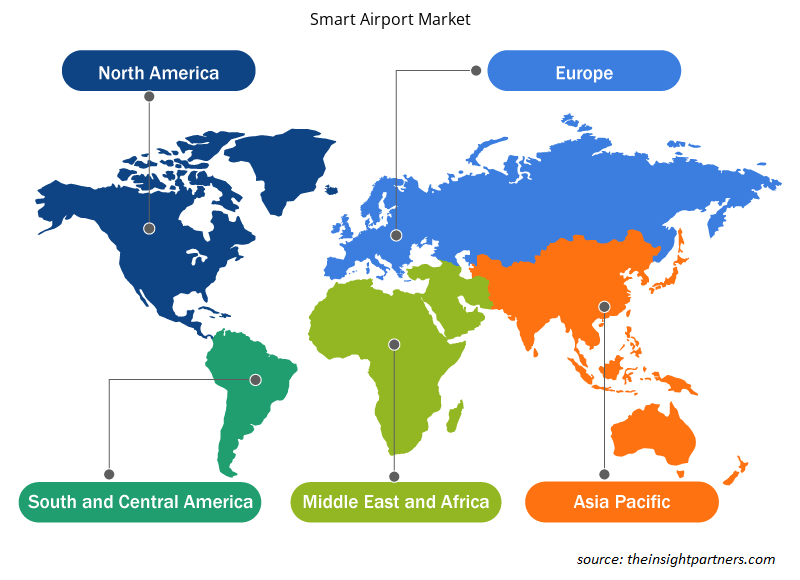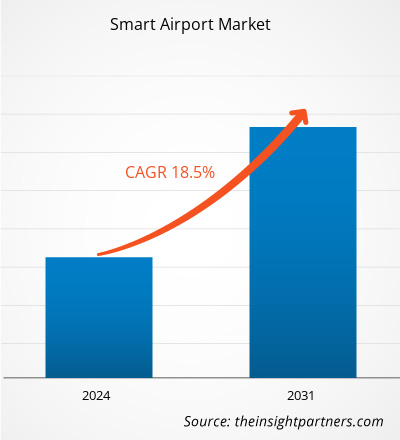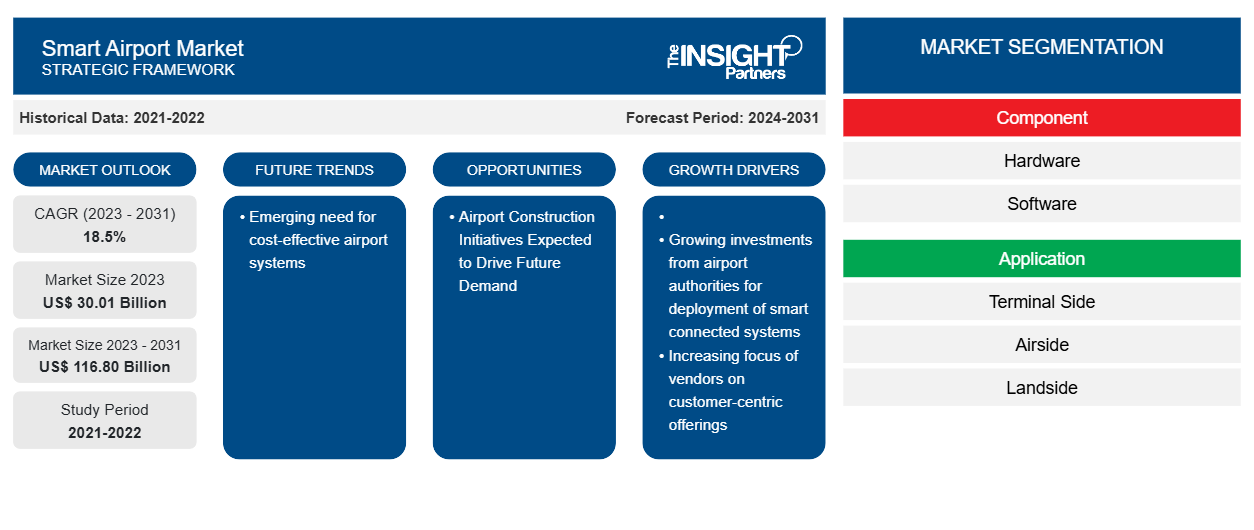スマート空港市場規模は、2023年の300.1億米ドルから2031年には1168億米ドルに達すると予測されています。市場は2023年から2031年の間に18.5%のCAGRを記録すると予想されています。コスト効率の高い空港システムに対する新たなニーズは、市場の主要なトレンドであり続けると思われます。
スマート空港市場分析
空港は、スマート空港システムメーカーからソリューションとサービスを受けています。さまざまな空港での AI および ML ベースのシステムの導入への投資が増加しているため、スマート空港向けの自動化システムの需要が高まっています。スマート空港エコシステムのコンポーネントメーカーは、インテリジェントデータ処理システム、人工知能バイオメトリクス、IoTセンサー、モデム、ルーター、ピールアンドスティックセンサーなどのスマートテクノロジーデバイスのメーカーと短期および長期契約を結んでいます。Amadeus IT Group SA、Cisco System、Inc、Huawei Technologies Co., Ltd、Honeywell International Inc.、Indra Sistemas SA、SABRE GLBL Inc.、Jeppesen、Zensors、およびSITAは、スマート空港システムのプロバイダーです。これらの企業は、エンドユーザーを対象に、エンドツーエンドのスマートデバイス、サービス、およびソリューションを提供しています。スマート空港システムの主なエンドユーザーには、シンガポールチャンギ空港、ソウル仁川空港、ヒューストン空港、東京羽田空港、香港国際空港、ドーハハマド国際空港、ミュンヘン空港、およびロンドンヒースロー空港があります。
スマート空港市場の概要
スマート空港市場のエコシステムの主な利害関係者には、部品メーカーとサプライヤー、ソフトウェア開発者とインテグレーター、スマート空港システムメーカー、エンドユーザーが含まれます。部品メーカーとサプライヤーには、Astronics Corporation、TE Connectivity、Molex、Panduit、Honeywell、Schneider Electricなどがあります。スマート空港の設置に対する政府の投資の増加により、空港のデジタル化が加速しています。スマート空港ではセキュリティが極めて重要であるため、多くのスマート空港当局が協力してこれらの施設のセキュリティを確保し、運用効率を改善しています。
要件に合わせてレポートをカスタマイズする
このレポートの一部、国レベルの分析、Excelデータパックなど、あらゆるレポートを無料でカスタマイズできます。また、スタートアップや大学向けのお得なオファーや割引もご利用いただけます。
- このレポートの主要な市場動向を入手してください。この無料サンプルには、市場動向から見積もりや予測に至るまでのデータ分析が含まれます。
スマート空港市場の推進要因と機会
市場ベンダーは顧客中心の製品提供にますます注力している
スマート空港業界の企業は、スマート空港技術の採用を促進するために、顧客中心のソリューションの提供に注力しています。乗客の手荷物追跡に対する需要は世界中で高まっており、これは空港当局の主な焦点領域の1つです。中国民用航空局(CAAC)によると、2021年には中国の航空乗客の約75%が手荷物の追跡詳細と引き取り時間を知りたいと考えていました。同じ調査によると、中国の航空会社の約86%が手荷物追跡通知の提供に重点を置いており、航空会社の57%は中国全土の乗客に手荷物の引き取り情報も提供しています。したがって、スマート空港市場のベンダーは、航空会社の業務を自動化し、乗客に優れた体験を提供するために、航空会社にスマート航空会社手荷物管理システムを提供することに重点を置いています。このようなシステムは、クラウドベースの航空会社のアプリケーションとデータベース、クラウドベースの分析、マシンツーマシン(M2M)およびIoTプラットフォームと統合されており、スマートラゲッジからのリアルタイムデータとイベントを接続、管理、保護します。さらに、空港に手荷物管理システムを導入すると、全体的な運用効率が向上するとともに、全体的な運用コストも削減されます。
新空港建設プロジェクト
中国やインドなどの新興国における空港建設プロジェクトの増加は、今後数年間で市場ベンダーに新たな機会を生み出す可能性があります。新空港の建設や既存空港の拡張/アップグレードに関連するいくつかの政府計画は、今後数年間でスマート空港システムの導入をサポートする可能性のあるもう1つの主要な要因です。たとえば、インド政府は2022年に、2025年末までに220の空港を建設する計画をすでに発表しています。さらに、2018年には、中国民用航空局(CAAC)が2035年末までに216の新しい空港を建設する計画を発表しており、2035年までに空港の総数は450になります(2023年現在234空港)。このようなプロジェクトは、今後数年間でスマート空港テクノロジー企業に新たな機会を生み出す可能性があります。
スマート空港市場レポートのセグメンテーション分析
スマート空港市場分析の導出に貢献した主要なセグメントは、コンポーネントとアプリケーションです。
- コンポーネントに基づいて、スマート空港市場はハードウェアとソフトウェアに分かれています。ハードウェアセグメントはさらに、セキュリティシステム、通信およびナビゲーションシステム、エンドポイントデバイス、データストレージシステムに分かれています。ハードウェアセグメントは2023年に大きな市場シェアを占めました。
- アプリケーションに基づいて、スマート空港市場はターミナル側、エアサイド、ランドサイドに分割されています。ターミナル側セグメントは2023年に大きな市場シェアを占めました。
スマート空港の地域別市場シェア分析
スマート空港市場レポートの地理的範囲は、主に北米、ヨーロッパ、アジア太平洋、中東およびアフリカ、南米の 5 つの地域に分かれています。
2023年にはアジア太平洋地域が市場を支配し、ヨーロッパと北米がそれに続きます。さらに、アジア太平洋地域は今後数年間で最高のCAGRを記録する可能性があります。アジア太平洋地域のスマート空港市場の主な推進力は、地域全体での多数のスマート空港プロジェクトの存在です。たとえば、アジア太平洋地域にある主要なスマート空港には、香港国際空港、深セン空港、北京大興国際空港、東京羽田空港、セントレア名古屋国際空港、ニューデリー国際空港、ハイデラバード国際空港、ソウル仁川空港、済州空港、シンガポールチャンギ空港、クアラルンプール国際空港、インドネシア空港などがあります。さらに、中国やインドなどの国は、2035年末までに400以上の空港を建設する可能性があり、今後数年間で市場をさらに牽引する可能性があります。
スマート空港市場の地域別洞察
予測期間を通じてスマート空港市場に影響を与える地域的な傾向と要因は、Insight Partners のアナリストによって徹底的に説明されています。このセクションでは、北米、ヨーロッパ、アジア太平洋、中東、アフリカ、南米、中米にわたるスマート空港市場のセグメントと地理についても説明します。

- スマート空港市場の地域別データを入手
スマート空港市場レポートの範囲
| レポート属性 | 詳細 |
|---|---|
| 2023年の市場規模 | 300.1億米ドル |
| 2031年までの市場規模 | 1,168億米ドル |
| 世界のCAGR(2023年~2031年) | 18.5% |
| 履歴データ | 2021-2022 |
| 予測期間 | 2024-2031 |
| 対象セグメント | コンポーネント別
|
| 対象地域と国 | 北米
|
| 市場リーダーと主要企業プロフィール |
|
市場プレーヤーの密度:ビジネスダイナミクスへの影響を理解する
スマート空港市場は、消費者の嗜好の変化、技術の進歩、製品の利点に対する認識の高まりなどの要因により、エンドユーザーの需要が高まり、急速に成長しています。需要が高まるにつれて、企業は提供内容を拡大し、消費者のニーズを満たすために革新を起こし、新たなトレンドを活用し、市場の成長をさらに促進しています。
市場プレーヤー密度とは、特定の市場または業界内で活動している企業または会社の分布を指します。これは、特定の市場スペースに、その市場規模または総市場価値に対してどれだけの競合相手 (市場プレーヤー) が存在するかを示します。
スマート空港市場で事業を展開している主要企業は次のとおりです。
- ハネウェルインターナショナル
- シスコシステムズ株式会社
- ファーウェイテクノロジーズ株式会社
- インドラ・システマスSA
- アマデウス IT グループ SA
- シータ
免責事項:上記の企業は、特定の順序でランク付けされていません。

- スマート空港市場のトップキープレーヤーの概要を入手
スマート空港市場のニュースと最近の動向
スマート空港市場は、主要な企業出版物、協会データ、データベースなどの一次調査と二次調査を経て定性的および定量的データを収集することで評価されます。スマート空港市場の動向のいくつかを以下に示します。
タレスは、空港管理グループであるSEA(Società per azioni Esercizi Aeroportuali)から、同グループの業務効率向上を支援する革新的なデジタルプラットフォームソリューションを提供する契約を獲得しました。(出典:タレス、プレスリリース、2022年3月)
- 11月20日から22日までオマーンのマスカットで開催される第1回空港イノベーション展示会で、ファーウェイは、完全接続ファイバーネットワークソリューションやファイバーセンシングソリューションを備えたスマート空港境界セキュリティなど、国際市場向けの一連のまったく新しいスマート空港ソリューションを発表しました。(出典:ファーウェイ、プレスリリース、2023年11月)
スマート空港市場レポートの対象範囲と成果物
「スマート空港市場の規模と予測(2021〜2031年)」レポートでは、以下の分野をカバーする市場の詳細な分析を提供しています。
- スマート空港市場の規模と予測(対象範囲に含まれるすべての主要市場セグメントについて、世界、地域、国レベルで)
- スマート空港市場の動向、推進要因、制約、主要な機会などの市場動向
- ポーターの5つの力の詳細な分析
- 主要な市場動向、世界および地域の枠組み、主要プレーヤー、規制、最近の市場動向を網羅したスマート空港市場分析
- 市場集中、ヒートマップ分析、主要プレーヤー、スマート空港市場の最近の動向を網羅した業界展望と競争分析
- 詳細な企業プロフィール
- 過去2年間の分析、基準年、CAGRによる予測(7年間)
- PEST分析とSWOT分析
- 市場規模価値/数量 - 世界、地域、国
- 業界と競争環境
- Excel データセット
最新レポート
お客様の声
購入理由
- 情報に基づいた意思決定
- 市場動向の理解
- 競合分析
- 顧客インサイト
- 市場予測
- リスク軽減
- 戦略計画
- 投資の正当性
- 新興市場の特定
- マーケティング戦略の強化
- 業務効率の向上
- 規制動向への対応





















 無料サンプルを入手 - スマート空港市場
無料サンプルを入手 - スマート空港市場